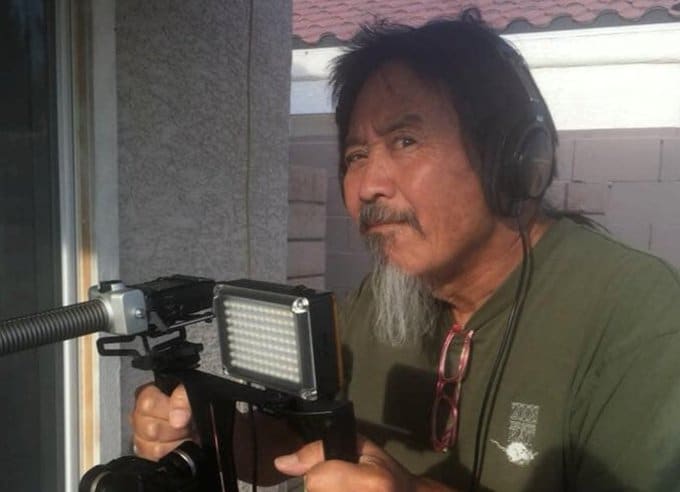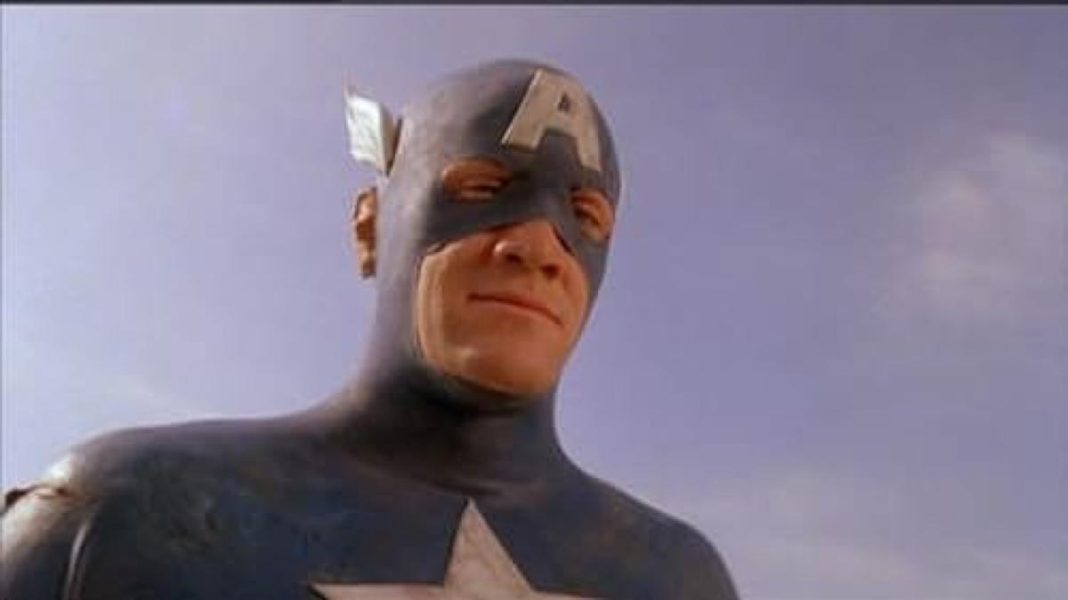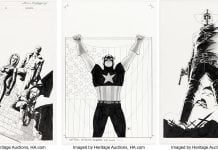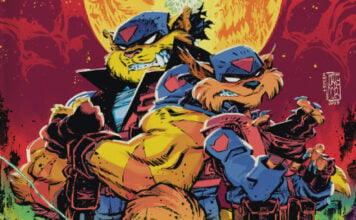by Nick Marino
Eight years before Blade slashed his way into our hearts and kickstarted Marvel’s cinematic rise to dominance, Captain America was supposed to throw his mighty shield on the big screen in 1990. Played by J.D. Salinger’s lanky son, Matt (yes, seriously), this Steve Rogers was a shy Manhattan Beach resident in love with his next door neighbor who made his community proud as he headed off to enlist in WWII, where he would go on to fight an Italian piano prodigy who had been transformed into the hideous Red Skull.
The filmmaker guiding this runaway bicycle of a film was the late Albert Pyun, best remembered for his bonkers R-rated low budget fantasy and sci-fi flicks like The Sword and the Sorcerer, Cyborg, Dollman, and Nemesis. In the mid-80s, Pyun hooked up with The Cannon Group, purveyors of high-octane cinematic junk food. The production and distribution powerhouse had found success in the action genre with hits including the Death Wish series, the Ninja trilogy, and Chuck Norris’s Braddock films. Pyun was a natural fit for Cannon, capable of delivering big action on a short schedule and a tight budget.
Pyun’s chaotic path to Captain America ran through three other big-name heroes: He-Man, Superman, and Spider-Man. Despite some critical and financial success in 1986, Cannon was stretched thin and looking down the barrel of bankruptcy in 1987 thanks to their wild wheeling and dealing. That summer delivered big back-to-back blows to their bottom line, with Superman IV: The Quest for Peace falling flat in July and Masters of the Universe massively flopping in August. At the time, Albert Pyun was attached to direct both a He-Man sequel and a Spider-Man film, planning to film them simultaneously to save money and maximize shooting schedules. Alas, a followup to Masters of the Universe was soon scuttled and Superman’s careening course ensured that a Spider-Man movie never materialized at Cannon.

Ever the resourceful filmmaker, Pyun made the best of the situation. He salvaged the $2 million already sunk into sets and costumes for He-Man and Spider-Man by quickly recycling the materials for his film Cyborg, a dystopian parable starring Jean-Claude Van Damme. While the movie easily made back its budget and then some, it wasn’t enough to save the ailing Cannon. Mega-producer Menahem Golan left Cannon in 1989, taking both Albert Pyun and the rights to two Marvel superheroes with him over to the 21st Century Film Corporation. While we all know 21st Century never made a Spider-Man movie, they managed to get their shit together just long enough to put Pyun on their other remaining option, Marvel’s patriotic crusader, Captain America.
Lacking the polish of DC predecessors like Dick Donner’s Superman and Tim Burton’s Batman, this Marvel adaptation has long been remembered for what it did wrong, not what it did right. Aesthetically, it was hard to escape the distractions posed by the film’s basement-level budget — Cap’s dingy suit had a cheap latex texture and it sported fake rubber ears on the sides of its mask. Even more confusingly, it was awfully hard to see the Albert Pyun-ness of it all in Captain America. The filmmaker was prone to salacious and bombastic storytelling, which couldn’t seem more absent from the overly-safe and borderline boring movie that finally went direct-to-video two years later in 1992.
Captain America was a formative viewing experience for my cousin and I as 10-year-old superhero fanatics. We eagerly rented the movie, popped the video tape into the VCR, settled into the family room couch, and promptly went on an emotional rollercoaster as the movie delivered confounding scene after confounding scene. Watching Captain America taught me about the joy of kitsch and ironic viewing, as we transformed our disappointment into a rowdy roast, bringing ourselves to tears as we mocked the movie. In my adolescence it was difficult to identify exactly what went wrong with the film, but as an adult it’s obvious that Pyun’s full vision didn’t make it to the screen.
That’s why the discovery of a Captain America director’s cut late last year was an unexpected and uplifting revelation. I was overjoyed to find that a screening would make its way to the west coast at this year’s Big Bad Filmfest, organized by filmmakers Powell Robinson and Patrick R Young. The latter is also a fellow comics writer, handling scripts for Red Hood: Outlaws, DC’s Spring Breakout, and the Ringo-nominated Nothing Butt Nightwing. So suffice to say that I was highly intrigued to see how they’d introduce Albert Pyun’s Captain America to a hungry audience on a hot August night in Glendale at the LOOK Dine-In Cinema. Robinson and Young opted for a sincere and loving tribute to Pyun, detailing the film’s troubled production including a final cut that was taken away from the director and a revised score that was a tonal mismatch.
Although I would’ve been equally satisfied with a classic campy viewing, what played next was a legitimate departure from the version of the beleaguered film that we all know. Albert Pyun’s Captain America is a far more sensible and stirring motion picture that plays with time in interesting ways and edits the action down to quick, close cuts that maximize the movie’s limited budget for costumes and choreography. The result isn’t a masterpiece per se, but it’s far from the disaster that went onto home video in the early 90s. The director’s cut features a more minimal score, letting many scenes remain gritty without any music at all, almost reminiscent at times of the game-changing Batman teaser trailer from 1989.
This original Captain America edit plays with time and concepts of memory in interesting ways. Steve Rogers and the Red Skull are posed as mirror images, both falling backwards into their own emotional recollections as the movie experiments with a non-linear structure that emphasizes the man-out-of-time aspect of Cap’s journey. Sure, the rubber ears are still on the mask and Ronny Cox is still using a Captain Midnight decoder ring as the President of the United States. But the emotional heft of this original cut far outshadows the ever-present camp of the version that Menahem Golan opted to release.
If you love the history of superhero cinema, I can’t emphasize enough how much you need to see Albert Pyun’s Captain America, both to witness what we lost to executive meddling and to understand what Pyun was aspiring to achieve. As of right now, it doesn’t seem like there’s a clear path to release for the director’s cut. Hopefully it will continue to screen at festivals as demand builds for proper access to home video and streaming. In the meantime, rest easy knowing that Albert Pyun wanted you to have the best version of this movie possible, and know that he strove to deliver a meaningful adaptation that did the shield-slinger justice in his first feature film.
Nick Marino is a comic book writer living in the South Bay of Los Angeles. His work includes Godzilla Rivals: Biollante Vs. Destoroyah, Transformers: Beast Wars Annual, Holy F*ck, KUTE Crew, and the upcoming Mighty Morphin Power Rangers Halloween Special, hitting shops on Wednesday, October 22nd from BOOM! Studios.
(Photos from screening ©Nick Marano)














I saw the original at a convention years ago. We talked about it at the time and the fact that Captain America disappears on his first mission and therefore no one ever would have heard about him.
I know what you mean, James. The way things play out in this cut, because the past is used mostly for emotionally charged flashbacks that play out as fleeting memories, I didn’t find myself mulling the plot holes that are made so obvious in the home video version.
It HAS been released on Blu-ray: https://yippeekiyaymothervideo.com/products/captain-america-standard-edition
That’s great! Thanks, Daniel. As of writing, there was only a limited sold out run from back in the spring, so I didn’t want to get anyone’s hopes up. Awesome to know that Yippee Ki-Yay has reupped.
Comments are closed.